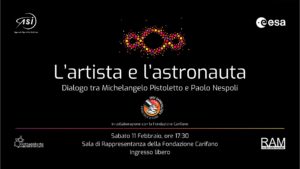Is there a link between art and astronomy? What relationship is there between the Third Paradise and the ISS – International Space Station? To get an initial – albeit partial – answer, we can refer to Michelangelo Pistoletto‘s latest book: “The Third Paradise,” we read, “was adopted by the ASI (Italian Space Agency) and ESA (European Space Agency) for the VITA (acronym for Vitality, Innovation, Technology and Skill) mission of Italian astronaut Paolo Nespoli (…). The mission’s symbol of Third Paradise was displayed in the orbital station in large size. During his six-month stay in space, Paolo Nespoli produced a series of images. An emblematic photograph is the one in which the astronaut holds in one hand the symbol of the Third Paradise made from a strip of fabric printed with the flags of the countries participating in the mission”. These passages from the book, entitled The Formula of Creation and published by Cittadellarte, highlight a binomial – not a dichotomy – between two apparently distant spheres. The protagonists of the VITA Mission will talk this Saturday, 11 February, at 5.30 pm, in the Reception Hall of Fondazione Carifano, during the Fano carnival; the exchange between Michelangelo Pistoletto and Paolo Nespoli will be recorded and made available for listening on the RAM radioartemobile page from Monday 13 February at 3 pm.

The event (with free admission) will present the audience with some passages from The Formula of Creationand will illustrate – through the direct testimony of its participants – the peculiarities of the VITA Mission, which kept Nespoli and the rest of the crew on the International Space Station (ISS) in orbit around our planet for 139 days in 2017. For the first time, an artistic symbol was used as the logo for a space mission: a new version of the Third Paradise, created for the occasion by Michelangelo Pistoletto. The trinamic symbol was selected by the ASI and the ESA as the central element of the space mission logo, thanks to the collaboration with RAM radioartemobile, a platform for contemporary art, and Cittadellarte. Three elements were featured in the sign-symbol: a DNA strand recalling life and science, a book representing culture and education, and the Earth as a symbol of humanity.

